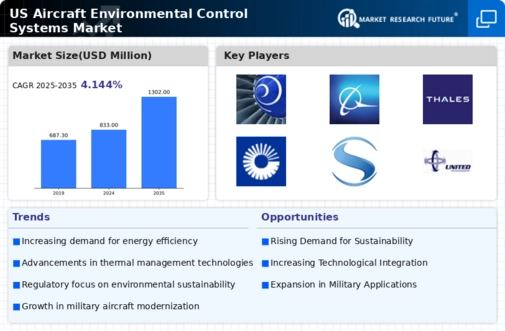Rising Competition Among Airlines
the aircraft environmental-control-systems market is influenced by rising competition among airlines. As carriers strive to differentiate themselves, the quality of onboard services, including environmental-control systems, becomes a focal point. Airlines are increasingly investing in advanced systems to enhance passenger comfort and satisfaction, which can lead to increased loyalty and market share. This competitive landscape is expected to drive innovation and improvements in environmental-control technologies. Consequently, the market may experience a growth rate of approximately 9% as airlines seek to leverage superior systems to attract and retain customers.
Growing Demand for Fuel Efficiency
the aircraft environmental-control-systems market is experiencing a surge in demand for fuel-efficient systems. Airlines are increasingly focusing on reducing operational costs, and environmental-control systems play a crucial role in achieving this goal. By optimizing cabin temperature and air quality, these systems can enhance fuel efficiency, potentially leading to savings of up to 15% in fuel consumption. As a result, manufacturers are investing in innovative technologies that improve the performance of these systems. The trend towards fuel efficiency is expected to drive the market, as airlines seek to balance operational costs with environmental responsibilities.
Technological Integration and Smart Systems
The integration of smart technologies into the aircraft environmental-control-systems market is transforming the industry. Innovations such as IoT-enabled systems allow for real-time monitoring and adjustments, enhancing operational efficiency. These smart systems can analyze data to optimize temperature and humidity levels, improving passenger comfort while reducing energy consumption. The adoption of such technologies is expected to increase, as airlines recognize the potential for cost savings and improved service quality. This trend may lead to a market expansion, with projections indicating a growth rate of approximately 8% annually over the next five years.
Regulatory Pressures for Emission Reductions
Regulatory pressures are significantly impacting the aircraft environmental-control-systems market. Governments are implementing stricter emissions regulations, compelling airlines to adopt more efficient environmental-control systems. Compliance with these regulations often necessitates the upgrade of existing systems, driving demand for advanced technologies. The market is likely to see an influx of investments aimed at developing systems that meet these regulatory standards. As airlines strive to comply with environmental regulations, the market could witness a growth trajectory of around 12% in the coming years, reflecting the urgency of addressing emissions.
Increased Focus on Passenger Health and Safety
In the aircraft environmental-control-systems market, there is a heightened emphasis on passenger health and safety. The demand for advanced air filtration and circulation systems is rising, as airlines aim to provide a safe travel environment. Systems equipped with HEPA filters can remove up to 99.97% of airborne particles, including viruses and bacteria. This focus on health is likely to influence purchasing decisions, as airlines prioritize systems that enhance air quality. The market is projected to grow as airlines invest in technologies that ensure passenger safety, potentially leading to a market value increase of 10% by 2027.





















Leave a Comment